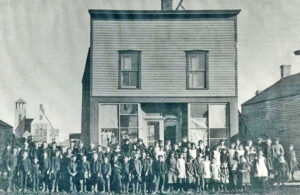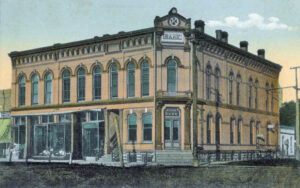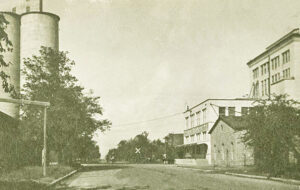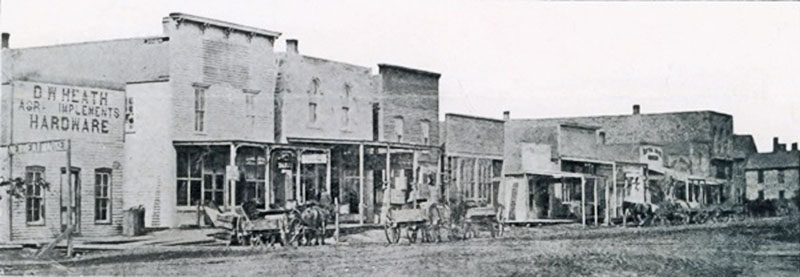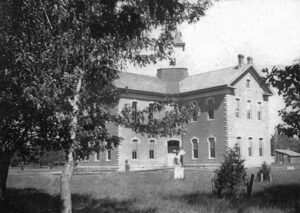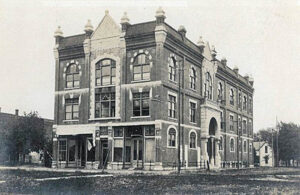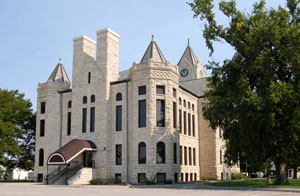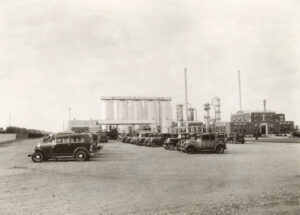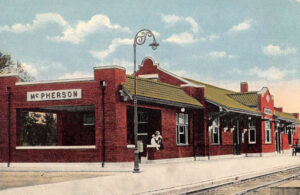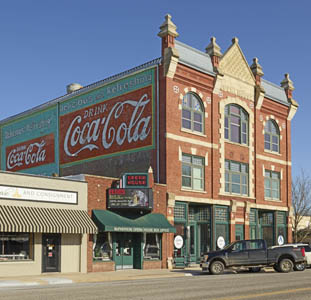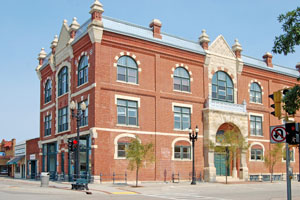McPherson, Kansas, is the county seat and largest city of McPherson County. As of the 2020 census, its population peaked at 14,082. It was named after Union General James Birdseye McPherson, a Civil War general.
The city was founded in 1872 by 12 members of the McPherson Town Company led by L.G. Skancke, who was chief clerk of the government land office at Salina, Kansas. At the time, he had been informed that a colony of Kentuckians was about to settle on “McPherson Flats,” so he conceived the idea of starting a town there. He interested several friends, and the party, which composed the town company, drove from Salina on Sunday, June 4, and located the town site, which they called McPherson Center. They made “improvements,” which consisted of Mr. Skancke digging a hole where the four-quarters of land met, Mr. Seitz breaking ground where the McPherson House would later be built, and Mr. Bishop excavating his pit where Lintner & Wheeler’s hardware store would be erected. On behalf of the company, the first filing on the site was made by James Marlin.
The following month, H. Bowker erected the first building and opened a store. In November 1872, the Yale Brothers started the first newspaper in McPherson and the county. It was called the McPherson Messenger and was Republican in politics. In December, the foundation of the town hall was laid.
A post office was established on January 21, 1873, with C.L. Raff as the postmaster. In the spring, the detachment of a tier of townships from the southern part of the county made McPherson the center of the county, and at an election held on June 10, 1873, it was made the county seat. The Town Hall on Main Street was completed that year, and the second floor was used as a one-room school. It cost $1,500 to build.
In February 1873, the McPherson Town Company Building was built for $1,250.00 at the northwest corner of Main and Marlin Streets. It was the headquarters of the little village’s government and civic activity, serving as a courthouse, city hall, schoolhouse, church meeting place, and newspaper office.
A Baptist Church was organized in 1873, and a 30 by 45-foot frame building was erected in 1874. A parsonage was built in 1878. The property’s value, including a parsonage and three lots, was $2,000 in the early 1880s when it had 82 members.
The Congregational Church was organized in June 1873 by Reverend Henry Hoddle. In 1878, a church building was begun and completed in 1879 for $3,500. In November 1882, its membership was about 65.
The Methodist Church was organized in 1874, with Reverend J. A. Simpson as its first pastor. The church building was erected in 1880 for about $5,000. In the early 1880s, it had a membership of about 150.
McPherson was incorporated as a city of the third class on March 4, 1874. The first election, at which 30 ballots were cast, was held on March 16 when officers were chosen: Mayor Sol Stephens, councilmen H. Bowker, C.E. Pierce, William West, W. B. McCord, and M.P. Simpson.
As early as 1875, city leaders of Marion, Kansas, met to consider a branch railroad from Florence.
On the night of March 1, 1875, an event that created excitement throughout the county was the robbery of the County Treasury. The day before, a committee had been busy examining the books at the office of the Deputy Treasurer, C.B. Bowker. David Stephens, the County Treasurer, was at his home on the Smoky Hill River. The county had no safe, and the funds were placed in charge of H. Bowker. The Examining Committee found that the books were not updated and gave the deputy until the following day to complete his work. Bowker’s house was entered the same night, and $3,300 in county funds was taken. On March 9, H. Bowker and C. B. Bowker were examined and charged with robbery, but the prosecution was considered malicious, and no evidence of a damaging character could be produced.
The McPherson County Agricultural Society was formed in August 1875, and the first fair was held October 11-12. The grounds were acres in extent and located about one mile north of McPherson, with few improvements.
A frame schoolhouse was built in October 1875 by B.S. Bonney.
In July 1877, a money order department was added to the post office.
The McPherson Bank was organized in March 1878 by Williams & Cottingham with a capital of $30,000. The firm owned its bank building and was prosperous.
In 1878, the Atchison, Topeka & Santa Fe Railroad and parties from Marion County and McPherson County chartered the Marion and McPherson Railway Company. In 1879, a branch line was built from Florence to McPherson.
In 1879, the Santa Fe and Union Pacific Railroads extended branches to McPherson, providing access routes for trade and travel.
C.G. Clarke organized the Central Bank of McPherson on April 22, 1879. It remained under the management of Clarke & McWhirk until January 1880, when Clarke became sole proprietor.
The Presbyterian Church was organized in June 1879 by Dr. Timothy Hill of Kansas City, with Reverend W. H. Honnell as its first pastor. It did not have a building but planned to erect one in the early 1880s. At that time, it had a membership of about 70.
The ”Little Giant” Elevator was erected in the fall of 1879 by Ed Berg & Co., proprietors. It had a capacity of 10,000 bushels with a property value of $4,000. The same year, the McPherson Elevator was erected in 1879 for $13,000. Owned by H. Hinckson & Co., the size of the building measured 30 by 62 feet and had a storage capacity of 30,000 bushels.
The McPherson Republican newspaper was first issued by Mead & Presbrey on December 4, 1879. It was published until June of that year when H. E. Watkins bought a half interest in the establishment. In June 1881, H.M. Conklin purchased Watkin’s interest, and the Republican was published under the firm Mead & Conklin.
The McPherson Mills were built in the spring of 1880. They were three stories in height, 36X40 feet, and the factory’s capacity was 100 barrels of flour daily. The proprietors were Colburn & Hamilton. They also operated an elevator in connection with the mills. Its property value was $18,000. W.C. Putt operated a fourth grain elevator.
The first opera house was on the second floor of the Bank of McPherson in 1880 and remained there until 1889.
The McPherson Leader was published in March 1880. It was discontinued in July 1881.
The railroad was extended to Lyons in 1880 and to Ellinwood in 1881. The Atchison, Topeka, and Santa Fe Railway leased and operated the line.
The Reverend Sevy organized the Christian Church (Disciples) in the winter of 1880-81, and by 1882, it had a membership of about 50. The organization did not own a church building but had a neat parsonage in the eastern part of the county.
By the early 1880s, McPherson had grown to a city of about 2,000 people and was considered one of the most flourishing towns of Central Kansas. It was the center of trade of an unrivaled agricultural country, settled by an industrious and intelligent class of people, many of whom were of foreign birth. It has railroad communication from the north over the Salina, Lincoln, and Western Railroad, a branch of the Kansas Pacific Railroad. The Marion & McPherson branch of the Atchison, Topeka, and Santa Fe Railway gave it free communications east and west. Not only was McPherson growing from a business point of view, but its educational, social, and religious advantages were also improving.
D.W. Heath & Co. also operated a grain elevator called the “People’s,” built in September 1881. Its capacity was 20,000 bushels, and its property value was $9,000.
McPherson had several good hotels and boarding houses. The Merchants and Commercial Hotels led the list. Benjamin Robinson took charge of the MMerchant’sHotel in May 1881. It contained 32 rooms and was well-patronized by the traveling public. The Commercial House was opened in July 1882 by J.S. Keller, its present manager and proprietor. It contained 22 rooms; the building measured 50 by 125 feet and was owned by the estate of H.F. Graper.
A fine brick two-story school building was completed for $12,000 in the winter of 1881-1882. It soon had an attendance of about 425 students. The first bank, the Farmers and Merchants Bank, was founded in the same year.
The FFarmers’and MMerchant’sBank was chartered on March 21, 1882, and commenced business on March 27. It had a capital stock of $30,000 and deposits of $50,000. The officers were W.J. Bell, president, and A.L. McWhirk, cashier.
The United Brethren Church of McPherson was organized on May 14, 1882. The church building was completed in the fall of 1882, the day of the dedication being fixed for December 17, 1882. The value of the church property, including three lots, was $2,000. Reverend W.H. Myers was the pastor, and there were about 20 members.
On March 1, 1883, a fire destroyed the town hall on the west side of Main Street and all buildings in the block from Marlin to Euclid Streets. The fire started at 10 p.m. in the rear of the Davis & Kehoe Billiard Hall from a discarded cigar; the pool tables were carried out before any attempts were made to extinguish the fire. The entire block burned down, including adjacent buildings on Marlin and Euclid, with a total loss of $55,000. The Town Company building was lost, but all records were saved.
On March 15, 1883, the McPherson Republican newspaper announced that the Union Hotel would be built on the burned-out block, covering 75 feet front on Main Street and 130 feet on Marlin Street. When completed, the hotel was three stories high, plus a basement with 50 sleeping rooms and a large dining room. The building was owned by George McCourt, the first mayor of McPherson, who also owned the livery stable. The hotel was later known as the McCourt.
A volunteer fire department was established in April 1883, with J.C. Hamilton as the first fire chief. The equipment was kept in a building on the southeast corner of Kansas and Maple Streets. Uniforms were purchased in August, and a fire engine and horse-drawn hose cart were added in September.
In January 1887, the Thompson-Houston Electric Light Company, a private power company, provided electricity to McPherson. In 1891, the company was sold to Western Water and Electric Company. The city purchased the company in 1908. The power plant burned down in 1910 and was rebuilt in 1911 with two Corliss compound engines delivering 400 horsepower.
In February 1887, H.B. Kelly, the owner of the McPherson Freeman newspaper, and A.W. Smith spearheaded an effort to relocate the capitol from Topeka to McPherson, a more central location in the state. The city spent $300 to lavishly entertain state legislators at the Opera House and local hotels with banquets, receptions, and Chinese lanterns illuminating Main Street. A convention was held in April 1888 in Abilene to generate support for the initiative, but the effort died due to limited influence. It never came to a vote at the state level.
In June 1887, horse-drawn street cars began running almost five miles north and south on Main Street and east-west on Kansas Avenue from the Missouri Pacific Railroad depot to McPherson College. A branch route ran to the cemetery only when there was a funeral. Initially run by the McPherson Street Railway Company, it was sold to William West. It boasted three cars — two on Main and one on Kansas Avenue, with 25 horses moving approximately four miles per hour. A car barn was located at the corner of Kansas and Elm Streets.
In 1887, a colony of German Baptists, sometimes called Dunkards, was located at McPherson, where McPherson College was later founded. Also, the Chicago, Kansas, and Nebraska Railroad built a main line from Herington through McPherson to Pratt. In 1888, this line was extended to Liberal. Later, it was extended to Tucumcari, New Mexico, and El Paso, Texas.
The same year, city officials began a failed attempt to have the community named the state capital. The town fathers laid out a 160-acre “Capitol Hill” and made a bid to become the state capitol. However, Topeka was selected, and McPherson went ahead with other plans.
The Missouri Pacific and Rock Island Railroad reached McPherson in 1888.
In March 1888, the men who formed a stock company to build a new Opera House had a bold vision. Work began immediately with contracts awarded to Ellison and Linn for the stone basement and to W.G. Reynolds for the building. By June, the stonework was almost finished, and the entire building was completed by mid-January 1889 for approximately $40,000. The three-story red brick eclectic-style structure at 221 South Main measures approximately 130 feet long, 50 feet wide, and 40 feet high and has a steeply pitched mansard roof. One of the first opera houses with electricity, it had no equal between Kansas City, Missouri, and Denver, Colorado. On opening night, on January 28, the Modoc Club of Topeka, Kansas, presented an opera entitled Chimes of Normandy. The bbuilding’s900 seats were filled in a town of less than 2,500 people, and box office receipts that evening amounted to $900. The Opera House quickly established itself as the county’s cultural center. From April 1889 until December 6, 1894, the McPherson County Commissioners rented the Opera House building, except for the main hall, for an annual fee of $1,400 for use as county offices until the new county courthouse was completed.
For the next 30 years, a steady stream of performers graced the stage of the Opera House. Because of its luxury and superb acoustics, it was a favorite venue of the assorted acts that crisscrossed the country by train. The Opera House also hosted political rallies, suffrage meetings, and numerous local productions and events. It was the primary place where the citizens of McPherson could meet, interact, and understand themselves to be a community.
By then, the community was at the junction of four railroad lines. Major industries have included a large flour mill, an insurance company headquarters, and an oil refinery.
The horse-drawn street cars ceased operation in 1890.
The Chicago, Kansas, and Nebraska Railway was foreclosed in 1891 and taken over by the Chicago, Rock Island & Pacific Railroad.
On May 1, 1894, the McPherson County Courthouse began to be constructed when the cornerstone was laid. At the same time, a two-story jail with matching limestone was built just north of the courthouse. The jail housed 20 prisoners and the sheriff’s living quarters.
In August 1896, the first telephone was installed at the Bixby-Lindsay Drug Store. McPherson businessmen raised the $1,000 needed by selling tickets, each worth a free phone call on the new phone. The phone was a toll phone connected to Salina.
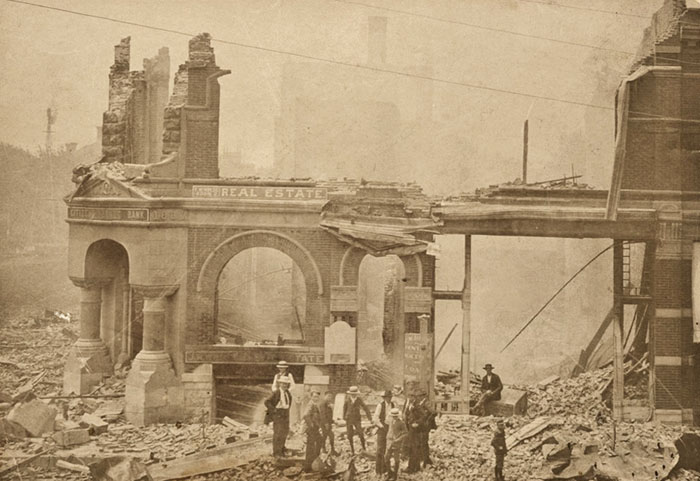
First National Bank, McPherson, Kansas Fire, 1898.
In July 1898, a fire destroyed the First National Bank at 101 N. Main, resulting in an estimated $75,000 loss.
In September 1905, Walden College opened. It was built for $35,000 as a Swedish Mission College.
In 1910, four of the essential railroads converged at this point, including the Atchison, Topeka & Santa Fe, the Chicago, Rock Island & Pacific, the Missouri Pacific, and the Union Pacific Railroad, making McPherson one of the important shipping points of this section of Kansas. At that time, it had five banks and several manufacturing establishments. The broom and sorghum factories were supplied by the broom corn and cane raised by McPherson County farmers, and each turned out a high-grade finished product. The cement works obtained its raw material from the northern part of the county. There was also a smoke consumer works and a stove drum factory. The McPherson Republican was published daily and weekly, and the Freeman, the Democrat, the Opinion, and Der Deutsche Western (German) newspapers were published weekly. The Rays of Light was a college publication issued monthly.
At that time, McPherson had two colleges. McPherson College was established some years ago by the German Baptist church, and Walden College was established in 1908 by the Swedish Evangelical church. Both were equipped with large, substantial buildings. In addition, McPherson had two good hotels, an opera house, three flour mills, which were among the largest in the state, four grain elevators, an ice and cold storage plant, an electric plant, a fire department, waterworks, and a sewer system. The streets were wide and well-kept, and the business blocks were brick or stone. Main Street was lined for several blocks with well-appointed retail stores. The town was supplied with telegraphic communications and express offices and had an international money order post office with seven rural routes. A board of trade had recently been organized, and a retail dealer’s association had been operating among the merchants for some years. The population of McPherson, according to the census of 1910, was 3,546.
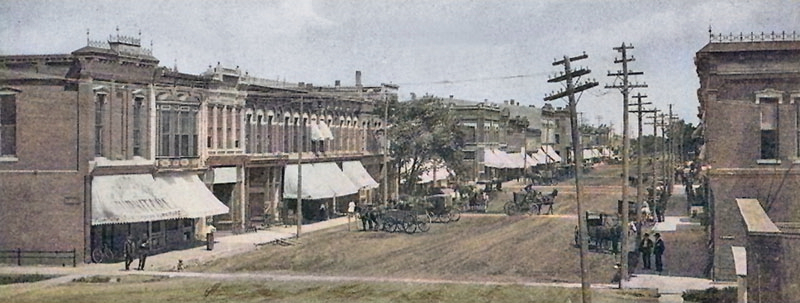
McPherson, Kansas Main Street, 1908.
The advent of movies changed the entertainment dynamics, and in the 1910s, several movie theaters opened in McPherson. Attendance at the Opera House, where admission was five to 15 times greater, began to dwindle.
The National Old Trails Road, also known as the Ocean-to-Ocean Highway, was established in 1912 and was routed through Windom, Conway, and McPherson.
Walden College was sold to the Free Methodists in 1914 to become Central Academy & College.
The Carnegie Library opened in November 1918. However, due to the influenza pandemic, no grand opening was held.
In the spring of 1925, the Opera House quietly closed its doors, and the two floors above were converted to apartments during the 1925–1929 remodel.
An announcement was made in May 1929 that the Opera House building would re-open as a modern motion picture theater called the “Empire.” The initial response was overwhelming, and 200 people had to be turned away on opening night on May 8.
At about that time, McPherson County struck oil, boosting the local economy and avoiding repercussions from the Great Depression.
The Empire Theater folded in 1936 to reappear as the Mac Theater three weeks later. Later, it was completely remodeled into apartments and business establishments. The west portion of the building was devoted to commercial interests, and the street level was retail.
World War II petroleum product shortages made it difficult for farm cooperatives to obtain the fuel they needed for their farmer members. To solve the problem, five regional farm supply cooperatives joined together and organized the National Cooperative Refinery Association. The group purchased the Globe Oil Refinery at McPherson, Kansas, in 1943, when the refinery produced 15,000 barrels per day.
In the following decades, McPherson continued to grow.
By then, television had radically changed entertainment habits with the arrival of the movies, and one by one, McMcPherson’sovie theaters closed: first, the Ritz, then the Manor. The Mac was the last downtown theater left standing, but it went dark in March 1965.
The Atchison, Topeka, and Santa Fe Railway line from Florence to Marion was abandoned in 1968.
In 1971, the old Opera House building housed an antique shop and a jewelry store.
In 1980, the Chicago, Rock Island, and Pacific Railway was reorganized as the Oklahoma, Kansas, and Texas Railroad. In 1988, it merged with the Missouri Pacific Railroad, and in 1997, it merged with the Union Pacific Railroad.
The old Opera House’s retail spaces had dwindled over time, and the last tenant, Continental Trailways, vacated the building in 1983. Afterward, the once proud McPherson Opera House fell derelict and was purchased by Peoples State Bank at a sheriff’s auction. The bank intended to demolish the building and replace it with a parking lot.
However, the McPherson Opera House Preservation Company saved the building from demolition in 1986, and the Peoples Bank and Trust deeded the building to the Preservation Company and provided initial seed money. The preservation company faced lawsuits, demolition orders, public skepticism, and a lack of funds to secure the structure’s stability in the following years.
But, the building was secured with a new roof, the Main Street storefront was restored to its original appearance, the exterior brickwork was repaired, and the Coca-Cola signs, dating from the early 1900s, were restored thanks to a grant from the Coca-Cola company. Various exterior projects were also completed, including restoring the Grand Entry. With historic tax credits, additional private donations, and grants, the one-story building adjacent to the Opera House on the north was purchased in 2000. It was remodeled as the Annex, with a ribbon cutting and Grand Opening on February 7, 2002. However, it wasn’t until January 2010, with the completion of the final phase of the Opera HoHouse’s8,500,000 rehabilitation, that the project was complete. Today, the McPherson Opera House offers historical appeal with 21st-century facilities, including meeting rooms, an art center, and a premier performance space.
In 1992, the Atchison, Topeka, and Santa Fe Railway line from Marion to McPherson was sold to Central Kansas Railway.
In 1993, after heavy flood damage, the Atchison, Topeka, and Santa Fe Railway line from Marion to McPherson was abandoned. The original branch line connected Florence, Marion, Canada, Hillsboro, Lehigh, Canton, Galva, McPherson, Conway, Windom, Little River, Mitchell, Lyons, Chase, and Ellinwood.
The McCourt Hotel building was demolished in 1984 to accommodate a building expansion of the McPherson Bank & Trust Co., the town’s first bank organized in 1878. The McPherson Bank & Trust Co. created this beautiful plaza for the people of McPherson as an outdoor civic center for many community activities. Today, the City of McPherson accepts this plaza as a gift from the Bank of America and rededicates its use to all citizens of the McPherson community. 201 North Main Street,
McMcPherson’sopulation peaked in 2020 at 14,082.
McPherson has developed into one of the most industrialized small communities in the nation. Centered in one of the largest wheat-producing areas of the United States, McPherson is also ranked among the top agricultural centers of Kansas.
Today, the community is served by McPherson USD 418 public school district. USD 418 has an early childhood center and four elementary schools, McPherson Middle School and McPherson High School. Private school options are also available at St. Joseph Catholic Church and School, serving students through sixth grade. Higher education includes McPherson College and Central Christian College.
The Opera House and the Courthouse are on the National Register of Historic Places.
McPherson is located in the central part of the county, about 25 miles northeast of Hutchinson and about 50 miles northwest of Wichita.
© Kathy Alexander/Legends of Kansas, updated July 2024.
Also See:
Kansas Counties
Kansas Destinations
Santa Fe Trail in McPherson County
The Santa Fe Trail Across Kansas
Sources:
Blackmar, Frank W.; Kansas: A Cyclopedia of State History, Vol I; Standard Publishing Company, Chicago, IL 1912.
CHS Inc.
Cutler, William G; History of Kansas; A. T. Andreas, Chicago, IL, 1883.
McPherson Museum
McPherson Opera House
National Register of Historic Places – Opera House
Tiki-Toki Timeline
Visit McPherson
Wikipedia


